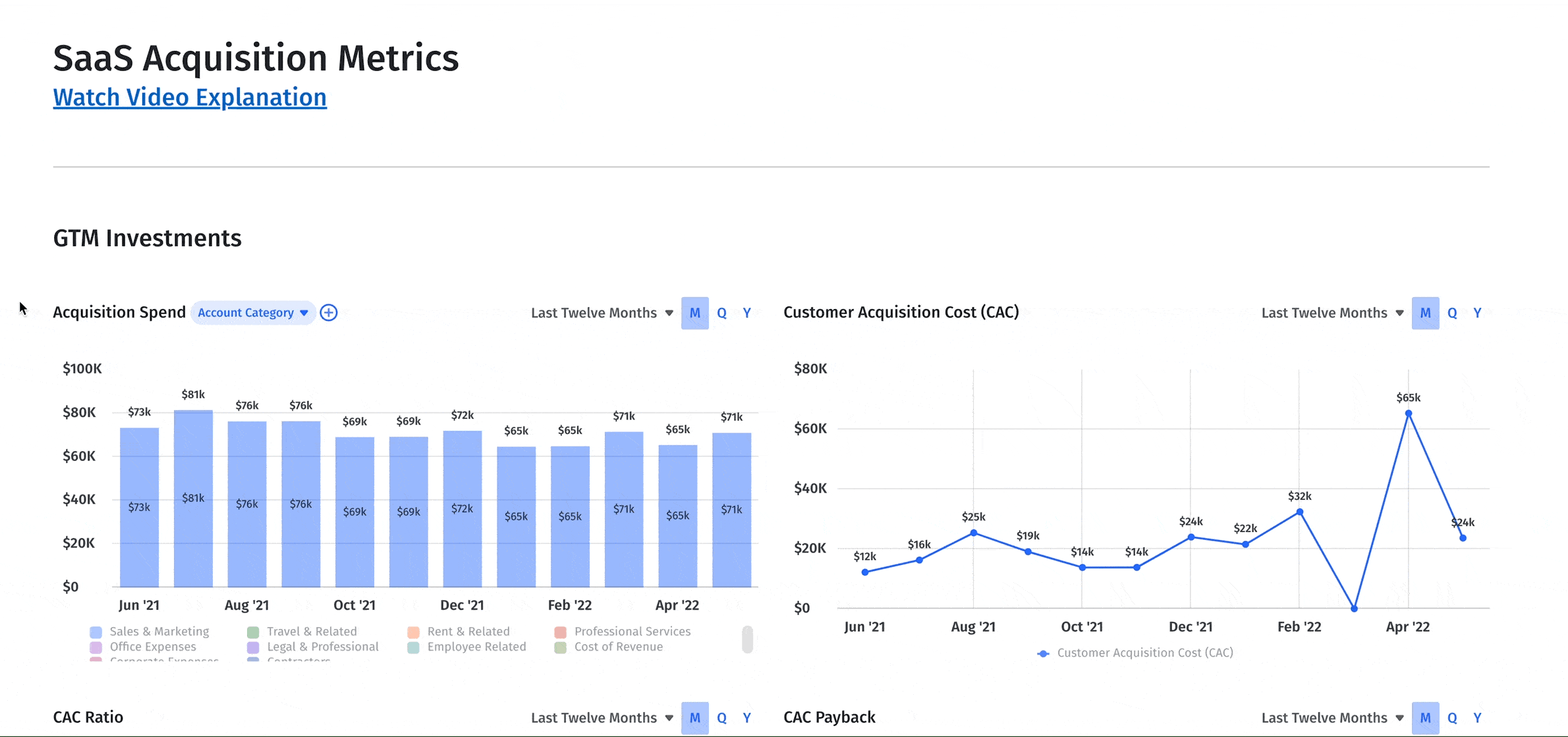If there’s one thing that could hold a high-growth company back from reaching its full potential, it’s incrementalism.
At least, that’s what Snowflake CEO Frank Slootman has said. In his experience, he’s found that “human tendency is to approach things incrementally, from an abundance of caution. It feels safer to inch forward rather than take bold leaps. Incrementalism is about avoiding risk by building on whatever has already been achieved as a stable foundation.”
This approach is at the heart of incremental budgeting. And while that approach may be the tried and true traditional budgeting strategy for large enterprises, it may not be the best option to bring into your fast-growing organization.
It’s valuable to understand what incremental budgeting is and how to use it as a baseline starting point for your financial planning processes. But in reality, SaaS businesses need to modernize budgeting to be as efficient and accurate as possible.
Table of Contents
What Is Incremental Budgeting?
Incremental budgeting is a budgeting process that involves using the current year’s budget as a baseline and then adjusting it by incremental amounts. You can perform either additions or subtractions to the current budget to create new quantities.
Incremental budgeting is typically accomplished by taking the last year’s budget and adjusting for some level of increased costs. Business budgeting software can help simplify the budget analysis and implementation process. You can also apply an incremental budget on a quarterly or monthly basis.
Incremental Budgeting Example
Incremental budgeting involves pretty simple adjustments and calculations. To find your budget for future periods, use the figures from your current period to estimate the starting point for your new budget. From there, you can add or subtract incremental amounts (as needed) to establish your budget for the next year or chosen period.
You can apply this approach to every piece of the company budget. Take employee compensation and headcount planning at the department level as an example.
Say your company has a marketing team of three. And, for simplicity, they each made $100,000 in salary for 2022. Your budget for 2023 has to account for annual compensation increases and an assumption that you’ll add two new members, each at $75,000.
In this case, the incremental budget increase might be 10% per employee as an annual salary increase while also accounting for the new headcount.
The formula for this year’s budget increase looks like this:
Current Period’s Budget = Previous Year’s Salaries + Percentage of Increment on Previous Wages + New Employee Salaries
For reference:
- Previous year’s salaries = $300,000
- Increment on previous wages (10% x $300,000) = $30,000
- New employee salaries (2 x $75,000) = $175,000
When you add these three amounts together — $300,000 + $30,000 + $175,000 — you get a total of $480,000 for marketing team comp in the new budget period.
Advantages of Incremental Budgeting
While incremental budgeting is largely considered the most conservative of all budgeting methods, it has a few distinct advantages.
Simplicity
Incremental budgeting doesn’t call for complex calculations or a detailed analysis from finance or accounting. Instead, only a few assumptions are required to perform this type of budgeting. This method of budgeting is quick to implement, even for business owners who don’t have a lot of experience or expertise with budgeting techniques.
Stability
Incremental budgeting works well for companies with predominantly static expenditures since this budgeting approach ensures funding remains stable over longer periods of time. That’s what makes incremental budgeting a good option for businesses working on long-term projects that require multiple years of funding, as it also simplifies the forecasting process.
Consistency
Because incremental budgeting relies on figures from the previous period, it ensures your overall budget remains consistent over time.
Equality
Incremental budgeting typically allocates equal incremental changes to your budget from one year to the next. Internal departments aren’t forced to compete with one another to acquire a larger portion of this budget.
Disadvantages of Incremental Budgeting
Despite its benefits, there’s no denying that incremental budgeting also has its downsides and inefficiencies.
Excess spending
Incremental budgets make adjustments based on department needs each year — so it’s not unusual for departments to spend as much of their budget as possible to receive more money the following fiscal year. Some departments may not actually need more money, but they’ll be allotted an increase due to the budgeting process allowing for it. Without careful analysis, this process can have a negative impact on your operational efficiency metrics and lead to unnecessary spending.
Lack of innovation
When new budgets are based on figures and line items from previous budgets, there’s little room to finance new ideas. Out-of-the-box campaigns end up in the trash because there isn’t any money available to invest in innovation.
Inflexibility
One of the main assumptions with incremental budgets is that your company’s operations go largely unchanged (i.e., they experience constant stability). Therefore, these budgets have a tough time responding to variances and external factors like an economic downturn, new market conditions, or emerging industry regulations.
Limited analysis
Incremental budgets don’t include an in-depth study of the budget itself. This lack of review makes the budget prone to waste, mistakes, and inadequate assumptions, all of which detract from the clarity and accuracy of said budget.
When It Makes Sense to Use Incremental Budgets
Incremental budgets are fairly common among established businesses because their simplicity and minimal lift is quite appealing — especially for large organizations that allocate funds to departments (or long-term projects) and who encounter only minor changes throughout the year. All in all, incremental budgeting is most effective in industries with steep competition, given that profits are (generally) preserved from year to year.
With that in mind, incremental budgeting isn’t well-suited for small businesses and early-stage startups who need more flexibility — since this budget model doesn’t allow you to respond quickly to moving targets. If you’re a SaaS startup in a fairly new industry vertical, you’ll likely want to consider rolling budgets or a different budgeting process since there are year-to-year cost fluctuations as you find your product-market fit (or work to disrupt a whole category).
Along those same lines, if your company is thinking about adding a new revenue stream or making changes to its headcount or office space, you may want to wait until costs have stabilized before you transition to incremental budgeting.
When you’re at different stages of funding and development, you need to keep an eye on using your budget correctly. That means leaning on allocation and sticking to your budget vs. increasing funds just to experiment with other go-to-market strategies.
For example, if you’re a Series A company, you might need to allot more money to R&D or engineering than you set aside for marketing. Your budget will likely remain low for a while since your expenses will be high as each department gets off the ground. But once you hit a stage of growth where you have product-market fit and are accelerating GTM metrics and motions, you can dive deeper into fine-tuning your budget.
Give Department Leaders Deep Financial Insights for Better Budgeting

How Mosaic Helps with Incremental Budgeting
The budgeting system for today’s SaaS businesses must be flexible and collaborative to succeed. Mosaic modernizes the end-to-end budgeting process so you can say goodbye to complex spreadsheets and embrace strategic finance initiatives. Mosaic helps your business focus on efficiency and real-time accuracy so you can make smarter business decisions for months (and years) to come.
Mosaic offers preloaded metrics, templates, and dashboards that help shorten the budget allocation and planning process from two weeks to two days, as well as a custom metric builder tool that allows you to slice your data exactly the way that you need. The SaaS acquisition metrics dashboard considers important KPIs like customer acquisition cost (CAC), CAC payback, and your SaaS magic number so that you can dig into the granular insights necessary to craft your company’s unique growth narrative.

With Mosaic, you can dive as deep as you need into your budgeting data, thus creating a more efficient and strategic process that keeps you moving in the direction of your goals. But don’t just take our word for it — request a personalized demo from Mosaic today.
Incremental Budgeting FAQs
What’s the difference between incremental and zero-based budgeting?
Incremental budgeting holds to the idea that a new budget is best developed by making marginal changes to your company’s current budget. Zero-based budgeting, on the other hand, creates a budget from scratch by analyzing each granular need of the company. Incremental budgeting is less responsive to changes and external factors, whereas zero-based budgeting is better equipped to handle changes in the economy and market conditions.
How are incremental budgets implemented?
What is an example of incremental budgeting?
What is the difference between static and incremental budgeting?
Own the of your business.

